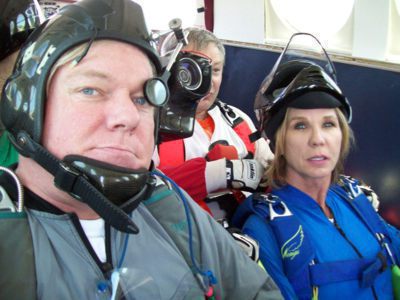Recommended Posts
Probably seeing the ground on exit adds to the feeling, I felt much more comfortable during my static line exit where I saw the plane for the most part. On my other jumps I was looking right at the ground and it definitely didn't feel good on exit. To be honest that feeling on exit is what makes me hesitant from making more jumps.
antonija 0
On the other hand our perception of reality (which is heavily distorted when we jump out of an airplane for the first (few) time(s)) might be different... but that's just us, not the universe we live in.
fastphil 0
Take the time to learn, there is a well paved path to BASE, and keep in mind some are destined while others are wannabes (all just my opinion)…
pchapman 279
There has been the discussion about the degree to which wind resistance slows the vertical component of the drop (vs the horizontal), and to what degree the two can be treated independently, and the degree to which jumpers may get some lift on exit depending on body position.
In any case, I think that part of the issue is also the influence of (a) other sensations and (b) the degree of familiarity with the situation.
In skydiving there is all the noise and wind blast, enough unusual sensation to begin with, that for many, there's no falling feeling noticed even from their first jump. While one's body may be signalling a sudden drop, one may not notice it with those other strong inputs coming in, including ones that signal to the brain that one does have some support -- The wind pressure may suggest to the brain that one isn't totally weightless and falling.
If one thinks about it one might notice the dropping a bit. But eventually it becomes 'normal' and not noticed, like someone wearing glasses can pretty much forget that they are on.
I remember getting a bit of the falling feeling back, when I was a novice jumper, when I did an exit on my back for example. It was a body position I wasn't yet used to, so I could for just a moment get that feeling of falling unexpectedly.
Robdiver 0
I actually did the math for this a while ago... I know I'm sad ![]()
Assuming a terminal velocity of 200km/h (125mph), I got:
at 10 sec : 190 km/h (118mph)
at 11 sec : 193 km/h (120mph)
at 12 sec : 195 km/h (122mph)
and so on... by then you will hardly notice the difference anyway.
That is all making a few assumptions like constant density etc. so not 100% accurate, but not far off.
As for that felling of accelerating, I get it every time, but I notice it less and less. Funny thing, I used a weight belt for the first time the other day and it made it feel worse. Obviously the weight belt wont increase the acceleration, but I think that it might make the acceleration last for longer...(i.e. longer until terminal velocity is reached). Second time i used the weight belt I hardly noticed the feeling at all. I recon you just get used to the feeling after a while.
keithbar 1
I've been told i go from exit straight to terminal ![]() guess that's why except for a few helo at a hover exits i've never experienced this
guess that's why except for a few helo at a hover exits i've never experienced this![]()
mdrejhon 8
200 jumps minimum is what I hear. That said, an accuracy parachutist (demo-lander-in-training) with just 150 jumps will outperform me.
My primary discipline is bigways, so while I can land in a large backyard (have done it once, more or less), big way jumps deprive me of the opportunity to concentrate on accuracy practice and rough terrian practice, and on lightly-loaded canopies, because a primary focus is safety -- keeping my head on a swivel.
So I think if I was to ever BASE jump, I think I need to rent/buy some rig resembling a BASE (i.e. 7-cell at less than 1.0 wingload) and get very good at it first. Although I'm not an antenna or building guy myself or rock-skimmer, I certainly would love to fly the Norwegian cliffs someday, or jump off a few legal arch bridges.
So even 400 jumps (me) is not enough for BASE. Depends on what kind of discipline you've been focussing on.
One of these days, someday, I'll be at a Bridge Day, at least as a spectator. ![]()
jakee 1,594
Although I wanted to do both before I even started skydiving, I started wingsuiting with a little over 200 jumps, and BASE with a little under 600.
Butters 0
JohnMitchell 16
That doesn't explain base jumps, balloon jumps, cutaways, etc.QuoteYou don't because at exit your ear juice is accelerating at the exact same speed as the melon you keep it in.
On an amusement park ride etc., you are being mechanically accelerated....zero G-ing your vertigo fluid, making your computer spaz out because of the conflicting sensory inputs.
The reason we don't feel weightless on exit is because of the airspeed of the aircraft. That wind actually causes an artificial acceleration, or deceleration, if you prefer, which causes a perception of gravity, just as hitting the brakes in the car makes your beer fly forward.
The curious thing is that the gravity vector is not straight down, but to the front of the airplane. This is an often ignored effect of "the relative wind" we all know and love. When you first jump out of a fast moving aircraft, straight down is truly not towards the Earth, but towards the front of the plane, whether you're talking about wind direction or gravity vector.







Consider this: You're in a giant plane with no windows (giant so it feels as stable as the ground and no windows so you can't tell if you're moving, how high you are, etc). There is a hole in the floor (but you can't see through it (It's an ACME hole. Don't ask).
While you are on this giant windowless plane you feel no different than being on the ground. You feel "normal" 1g of gravity and no wind.
Now pilot of this plane starts deep dive (you guessed it, at 1g downwards). Do you get that sick feeling?
Now pilot stops the fall and you feel "normal" 1g again, just as if you were on the ground. And all of the sudden a trap door opens up under you and you fall out of the plane (plane is traveling at 80mph). Do you get that sick feeling?
After few seconds of fall that feeling goes away... kind of. I guess your body gets used to it and stops bugging you until the next sudden change of vertical speed.
To sum it up: On the plane (as on the ground) your inner ear, stomach and just about every other organ will experience normal gravity _plus_ the force of floor/ground keeping you from falling through.
When you jump your body is not supported any more by the floor/ground and all your inner workings start to "float" inside your body (which really isn't much of a problem since we're filled with water anyway) and that's when you feel this sudden change.
Everything above was "done" at normal gravity (1g).
Amusement parks do something else. They accelerate you further than just gravity would. There it can go up to 4g's of acceleration and your body will probably register that more intense than your everyday 1g. You are also accelerated in many directions, not just your everyday straight down.
Share this post
Link to post
Share on other sites